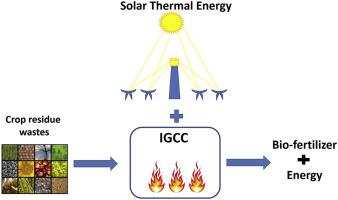Environmental Pollution ( IF 8.9 ) Pub Date : 2020-06-28 , DOI: 10.1016/j.envpol.2020.115103 Shahid H Ansari 1 , Ashfaq Ahmed 2 , Abdul Razzaq 3 , Diane Hildebrandt 4 , Xinying Liu 4 , Young-Kwon Park 5

|
Biomass integrated gasification combined cycle (IGCC) is attracting increased interest because it can achieve high system energy efficiency (>50%), which is predicted to increase with the increase in the solar share in biomass IGCC. This study evaluated the potential of crop residues numerically for the co-production of power and bio-fertilizer using ASPEN Plus® simulation software. The results showed that the gas yield increases with increasing temperature and decreasing pressure while the yield of bio-fertilizer is dependent on the biomass composition. The biomass with a low ash content produces high bio-fertilizer at the designated gasification temperature. The IGCC configuration conserves more energy than a directly-fired biomass power plant. In addition, the solar-assisted IGCC attains a higher net electricity output per unit of crop residue feed and achieves net thermal efficiencies of around 53%. The use of such hybrid systems offer the potential to produce 0.55 MW of electricity per unit of solar-thermal energy at a relatively low cost. The ASPEN Plus model predicted that the solar biomass-based IGCC set up is more efficient in increasing the power generation capacity than any other conversion system. The results showed that a solar to electricity efficiency of approximately 55% is achievable with potential improvements. This work will contribute for the sustainable bioenergy production as the relationship between energy production and biomass supplies very important to ensure the food security and environmental sustainability.
中文翻译:

将太阳热能纳入气化过程,以共同生产生物肥料和电力。
生物质整体气化联合循环(IGCC)吸引了越来越多的关注,因为它可以实现较高的系统能效(> 50%),预计随着太阳能在生物质IGCC中所占份额的增加,该效率也会提高。这项研究使用ASPENPlus®模拟软件,以数字方式评估了农作物残渣用于发电和生物肥料联产的潜力。结果表明,随着温度的升高和压力的降低,气体的产量增加,而生物肥料的产量则取决于生物量的组成。灰分含量低的生物质在指定的气化温度下会产生高生物肥料。与直接燃烧的生物质发电厂相比,IGCC配置节省更多的能源。此外,太阳能辅助的IGCC每单位作物残渣饲料的净发电量更高,净热效率达到53%左右。这种混合系统的使用提供了以相对较低的成本产生每单位太阳热能0.55兆瓦的电力的潜力。ASPEN Plus模型预测,基于太阳能生物质的IGCC装置在增加发电量方面比任何其他转换系统都更加有效。结果表明,通过潜在的改进,可以实现约55%的太阳能发电效率。这项工作将为可持续的生物能源生产做出贡献,因为能源生产与生物量供应之间的关系对于确保粮食安全和环境可持续性非常重要。这种混合系统的使用提供了以相对较低的成本每单位太阳热能产生0.55兆瓦电力的潜力。ASPEN Plus模型预测,基于太阳能生物质的IGCC装置在增加发电量方面比任何其他转换系统更为有效。结果表明,通过潜在的改进,可以实现约55%的太阳能发电效率。这项工作将为可持续的生物能源生产做出贡献,因为能源生产与生物量供应之间的关系对于确保粮食安全和环境可持续性非常重要。这种混合系统的使用提供了以相对较低的成本产生每单位太阳热能0.55兆瓦电力的潜力。ASPEN Plus模型预测,基于太阳能生物质的IGCC装置在增加发电量方面比任何其他转换系统更有效。结果表明,通过潜在的改进,可以实现约55%的太阳能发电效率。这项工作将为可持续的生物能源生产做出贡献,因为能源生产与生物量供应之间的关系对于确保粮食安全和环境可持续性非常重要。ASPEN Plus模型预测,基于太阳能生物质的IGCC装置在增加发电量方面比任何其他转换系统更为有效。结果表明,通过潜在的改进,可以实现约55%的太阳能发电效率。这项工作将为可持续的生物能源生产做出贡献,因为能源生产与生物量供应之间的关系对于确保粮食安全和环境可持续性非常重要。ASPEN Plus模型预测,基于太阳能生物质的IGCC装置在增加发电量方面比任何其他转换系统更为有效。结果表明,通过潜在的改进,可以实现约55%的太阳能发电效率。这项工作将为可持续的生物能源生产做出贡献,因为能源生产与生物量供应之间的关系对于确保粮食安全和环境可持续性非常重要。



























 京公网安备 11010802027423号
京公网安备 11010802027423号